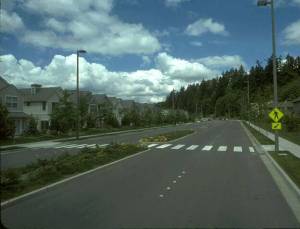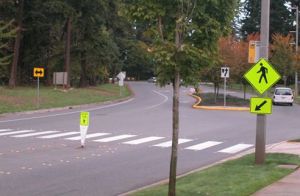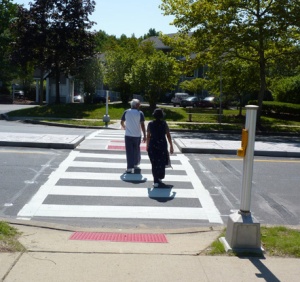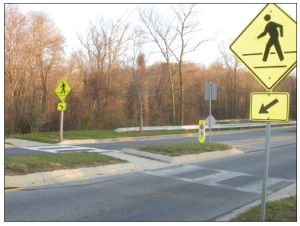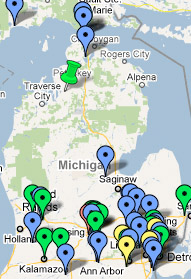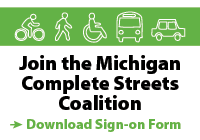You are currently browsing the monthly archive for January 2014.
We know that biking is good for us—but is it good for business? Let’s distill a blog series by People for Bikes and Triple Pundit to take a closer look at reasons why employers and governments should be supportive of cycling when planning infrastructure and promoting towns, cities and regions.
In recent years, bicycling has gained traction as a viable transportation option for commuting and reaching destinations around town. Nationally, bike commuting has increased by 10% since 2011, and more than 61% since 2000. Businesses and government have a prime window of opportunity to capitalize on this trend, not just as a matter of social responsibility but as a boon to the bottom line.
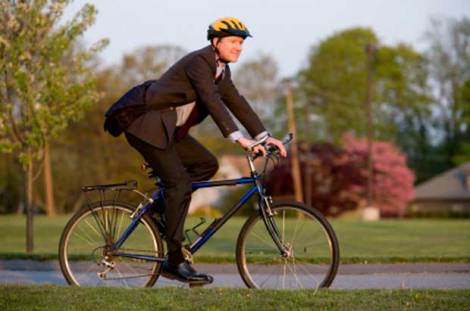
By encouraging bicycling, businesses and governments can take advantage of several benefits. (Photo Source)
Bicycling to work can help enhance employee health, thereby lowering health care costs for their employer. The blog series mentions several health benefits of bike commuting, including improved cardiovascular health, better mental health, and stronger immune systems. As health care costs continue to rise, encouraging bicycling commuting is a proactive step to lower costs. The Centers for Disease Control estimates that employees bicycling to work could save employers 5-12% on health care costs.
Bicycling to work can also help increase employee productivity, contributing to a more efficient workforce. Author Bob Siegel makes a strong case that promoting biking is an investment, and increased productivity will offset infrastructure costs the employer may incur. Benefits mentioned include:
- Exercising before work raising an employee’s productivity by an average of 15 percent.
- Cyclists taking 15 percent fewer days off work due to illness.
- Statistics that show non-cyclists take two more sick days per year.
- Studies that show a 4-15 percent increase in productivity, and 27 percent fewer task errors for physically fit employees.
For Michigan employers looking for an extra edge (not to mention healthier employees), encouraging bicycle commuting is an innovative way to boost productivity.
What can early adopters do to encourage bicycling to work? The League of American Bicyclists lists several strategies for businesses participating in its Bicycle Friendly Business program. Employers can provide cash incentives for biking to work, secure bicycle parking, reimbursement for purchasing bicycling gear, and provide locker or shower accommodations. Management can work with local cycling groups and city officials to make bicycling more user-friendly, and can provide employees with bicycling education, such as maps or safety literature. In Michigan, 14 businesses are certified by the League as Bicycle Friendly Businesses, including Trans4M membersMichigan Fitness Foundation and the League of Michigan Bicyclists.
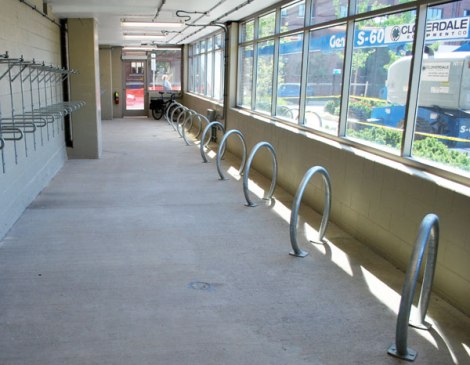
The University of Michigan offers indoor bike parking in one of its parking garages. (Photo source)
Michigan governments have even more incentive to promote bike commuting and invest in bicycling infrastructure. As employers, Michigan governments reap the same productivity and health care benefits as private and non-profit entities mentioned above. Further, bicycling infrastructure has positive effects on the city as a whole. Increasing ridership numbers show the public’s affinity for using bicycles as a serious mode of transportation. At the same time, fewer Americans are driving cars, especially younger people. These trends point to residents wanting to live in cities that accommodate biking and other nonmotorized modes of transportation. Having bike-friendly infrastructure contributes to healthier communities, less traffic congestion, and is a great way to attract millennials and the younger “creative class” that provide aneconomic and social boost to communities. Biking infrastructure fits in perfectly with various placemaking efforts underway in Michigan communities. Bike sharing programs accomplish the same result, increasing a city’s attractiveness as a place to live and visit. Michigan’s fledgling bike-sharing infrastructure is set to take a great leap in 2014, with bike-share programs operating in Detroit, Lansing, and Traverse City, and programs planned in Ann Arbor and Mount Pleasant.
From an economic standpoint, bicycle infrastructure improvements can be a driver of economic development. In Portland, Oregon, the City Club of Portland completed a first-ever cost-benefit study of bicycling investments in a U.S. city, and found that for every dollar spent on cycling-friendly projects, between $1.20 and $3.80 was returned in health and fuel savings. Local businesses benefit from increased biking and pedestrian traffic, especially when the businesses are located near bike racks. Cyclists riding in the city frequent retailers more often than drivers and spend more money on average, and Realtors often see bike infrastructure as a selling point for properties. In Indianapolis, homes close to the city’s Manon trail are worth 11% more than homes a half mile away, with all other variables controlled.
Bicycling advocacy and infrastructure make good economic sense for Michigan businesses and governments. Continued advocacy by employees and residents will help get programs and improvements where they need to be, benefiting both the employee and employer. Bicycling infrastructure will facilitate local business and help make bike-friendly cities desirable places to live, work, and play. Bicycling is on the rise in Michigan, and those who capitalize on the trend will reap the benefits.
###
Written by: Jeff Prygoski, Fellow, Transportation for Michigan
Cover photo credit
This post continues an ongoing blog series highlighting various complete street elements, their benefits, and use in Michigan communities. Check back often to catch future posts, and keep a lookout for mid-block pedestrian crossings in your community!
What are Mid-Block Pedestrian Crossings? Mid-block pedestrian crossings are marked crosswalks placed between intersections. They look similar to intersection crosswalks, but often incorporate several design features to increase safety. Mid-block crossings frequently include pedestrian islands, which provide a safe refuge for pedestrians crossing two-way traffic. Users can check traffic one way, cross to the island, and check traffic in the other direction before continuing to cross. Yield lines can be set back to require vehicles to stop farther away from the intersection. Bulb-outs that narrow the roadway can be used to calm traffic by slowing speeds, and can make pedestrians more visible to drivers. Where traffic volumes are heavy, mid-block crossings can be signalized to further increase safety and comfort.
Why Use Mid-Block Pedestrian Crossings? Many people do not go out of their way to cross at established intersections. Instead, they choose to cross the street using the most direct route, even if that means crossing several lanes of busy traffic. Mid-block pedestrian crossings decrease random and unpredictable crossings associated with a high risk of collisions, especially in areas that are heavily travelled by pedestrians or where block lengths are long.
When to Use Mid-Block Pedestrian Crossings: An engineering study should be completed to determine the need for a mid-block crossing, which incorporates roadway width, traffic volume, traffic speed and type, desired lines for pedestrian movement and adjacent land use. Heavily traveled areas that have high incidences of random crossings are good candidates for mid-block crossings, including schools, shopping centers, transit centers, and college campuses.
The above factors also determine whether bulb-outs, pedestrian islands, and signals should be incorporated into the mid-block crossing design. In general, local roads with low speeds and low traffic volumes are less likely to need these additional elements. As speed limits, number of lanes, and traffic volumes increase, these additional traffic calming and safety elements become increasingly necessary.
Safety Benefits: Mid-block locations account for more than 70% of pedestrian fatalities. Mid-block pedestrian crossings increase safety by decreasing random and unexpected pedestrian crossings. As stated before, people tend to cross where it is most convenient for them to cross, creating a high risk of collisions. Mid-block pedestrian crossings consolidate pedestrian traffic and allow drivers to predict and expect pedestrian traffic. Around 83% of pedestrians surveyed in an East Lansing, MI study changed their crossing behaviors where mid-block crossings were present. Where pedestrian islands have been included in the crosswalk design, pedestrian crashes were reduced by 46% and vehicle crashes were reduced by 39%. Because mid-block crosswalks can be difficult to use for individuals with visual impairments, adding a crosswalk signal to the crossing will help make the treatment safer for all users.
What Drivers Should Know: While mid-block pedestrian crossings help drivers know where pedestrians are most likely to cross, some pedestrians may still choose to cross at random points along the road. Accordingly, drivers should remain alert for pedestrians crossing outside of the crosswalk. Be aware of signage that will signal a mid-block crossing is approaching. When coming up to unsignalized and signalized mid-block crossings, drivers should prepare to yield in anticipation of pedestrians crossing. Where a pedestrian is on a crosswalk or when alerted by signal, a driver must stop behind the yield lines that proceed the crosswalk.
Cost Considerations: Costs for mid-block pedestrian crossings can vary significantly with mid-block characteristics and the need for pedestrian islands, signals, or bulb-outs. Additional treatment costs include Bulb-outs, which can cost between $5,000 and $25,000 per corner, pedestrian islands, which can run between $4,000 and $30,000, and countdown/crosswalk signals, which can cost between $5,000 and $15,000. More Expensive Pedestrian Hybrid Beacons can be included if deemed necessary. Adding these elements during planned construction will help to decrease project costs.
Mid-block pedestrian crossings are common in Michigan. A few examples include: East Lansing, which has a mid-block crosswalk that covers five lanes of traffic, and includes a pedestrian shelter; a short mid-block crossing between Michigan and Allegan along Washington Street’s business district in Lansing; and a crossing outside Frost Elementary School in Jackson.
Have mid-block pedestrian crossings in your community? Let us know.
Check out these resources for more information:
Best Design Practices for Walking and Bicycling in Michigan (Pages 26, 27, 29, and 32)
Crossing Enhancements Commonly Used in Mid-block Crossings
FHWA Course of Mid-block Crossings
MDOT Presentation on Design Ideas to Improve Pedestrian and Bicycle Safety
Mid-block Fact Sheet from Kansas DOT
Next Topic: Road Diets
Previous Topic: Contra-flow Bike Lanes
By Dennis Pelham
Daily Telegram Staff Writer
Posted Jan. 11, 2014 @ 3:00 pm
ADRIAN
Philosophical opposition to state government influence to create local bicycle and pedestrian paths gave way to concern for economic growth in Lenawee County.
The county commission overrode opposition from the county parks commission, the road commission and several townships to vote support Wednesday for the state’s Complete Streets Initiative. A resolution titled “comprehensive transportation systems” passed by a 6-2 vote.
Two citizens spoke against supporting Complete Streets before the vote.
Kathy Klumpp of Franklin Township said the parks commission voted against a Complete Streets resolution in July after debating the issue for four months.
“I am surprised that you commissioners are taking up this issue again so soon, and would like to know who or what is influencing you to possibly do an about-face?” she said Wednesday, reading from a prepared statement.
“Will you stand up and defend my private property rights if I am faced with claims of eminent domain because of a Complete Streets mandate?” she asked.
Chip Conin of Morenci said he believes Complete Streets is part of a government social engineering effort to force a reduction in automobile use.
“It’s time we look forward,” said commissioner Cletus Smith, R-Madison Twp.
He asked to put the resolution on Wednesday’s agenda, he said, because he believes it is needed to advance economic growth efforts in the county. The measure will improve grant opportunities for businesses and local governments, he said.
“I’m having a real hard time with this,” Smith said. He still believes the county should not try to dictate how the road commission and local governments spend their road money, he said, but he also believes economic development is a higher priority.
County administrator Martin Marshall said the resolution does not mandate local governments and other agencies to do anything.
“What you are resolving to do is comply with state statutes,” Marshall said. State law already requires the county’s master plan and parks plan to consider bicycle paths and other non-motorized transportation options.
“You don’t have to do them,” Marshall said.
State law already requires that all transportation options be considered in government plans at all levels, said commissioner David Stimpson, R-Tecumseh.
“You don’t have an option,” he said. “That’s what the law says.”
Commissioner Terry Collins, R-Adrian, said local governments are aware of all the costs and requirements involved in grants when they apply for them. And pedestrian and bicycle paths are an asset for communities.
“There’s a quality-of-life issue that has to be addressed here,” Collins said.
Commissioner Jim Driskill, R-Hudson, said he enjoys using a bicycle path the city of Hudson has developed and is in the process of expanding.
“I for one would have to support the Complete Streets because of what I’ve seen,” he said.
“I believe this is very important,” said K.Z. Bolton, D-Adrian. The resolution will enhance local governments’ ability to provide options such as bicycle and pedestrian paths and urged a vote “to open the door for the community with this tool.”
Voting against the resolution were commissioners Chris Wittenbach, R-Clinton, and Jack Branch, R-Onsted. Commissioner Ralph Tillotson, R-Adrian Twp., was absent.
Wittenbach said he was voting no because of opposition votes by the parks commission and boards of three townships in his district.
This article originally appeared in the Daily Telegram on January 11th, 2014. Used here with author’s permission.

